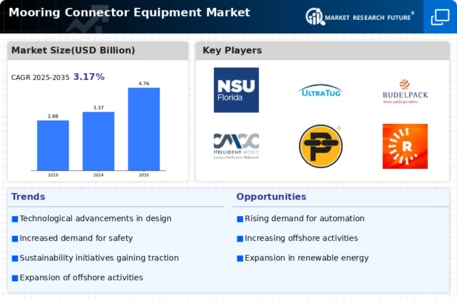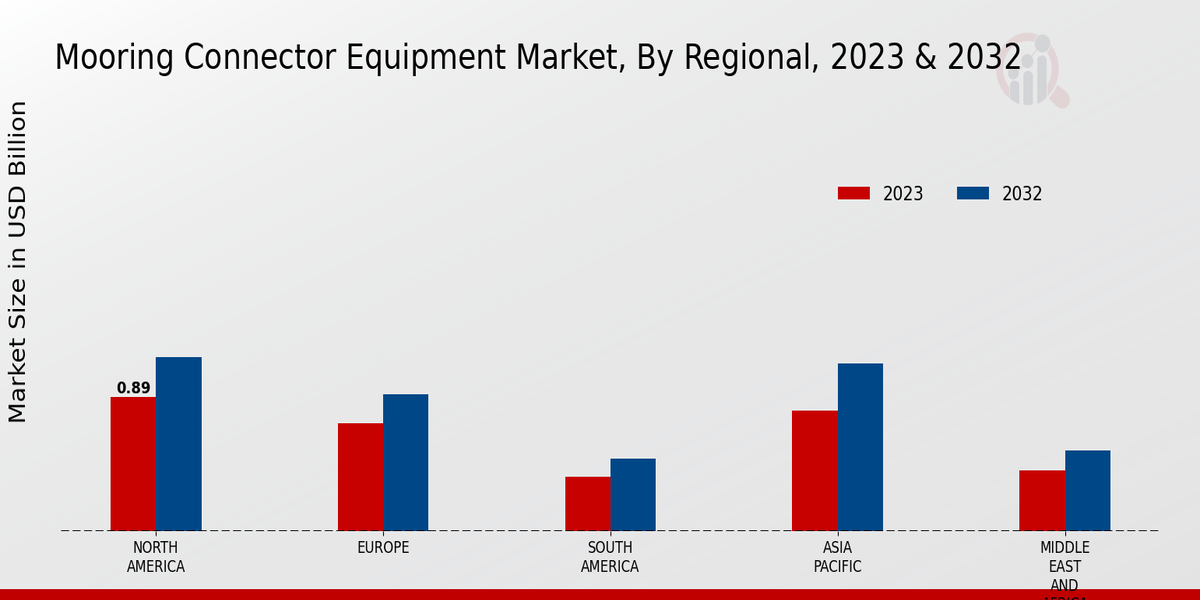Market Growth Projections
The Global Mooring Connector Equipment Market Industry is poised for substantial growth, with projections indicating a market value of 3.37 USD Billion in 2024 and an anticipated increase to 4.76 USD Billion by 2035. This growth trajectory suggests a compound annual growth rate (CAGR) of 3.18% from 2025 to 2035, reflecting the industry's resilience and adaptability to changing market conditions. Factors such as technological advancements, regulatory support, and increasing demand for offshore energy are expected to drive this growth. The market's expansion is indicative of the vital role that mooring connector equipment plays in supporting global maritime operations.
Increasing Demand for Offshore Energy
The Global Mooring Connector Equipment Market Industry experiences a surge in demand driven by the growing offshore energy sector. As countries invest in renewable energy sources, particularly wind and tidal energy, the need for reliable mooring solutions becomes paramount. For instance, the expansion of offshore wind farms necessitates robust mooring systems to secure floating platforms. This trend is reflected in the projected market value, which is expected to reach 3.37 USD Billion in 2024, indicating a strong upward trajectory. The industry's growth is likely to be sustained as more nations commit to renewable energy targets, further enhancing the demand for advanced mooring connector equipment.
Regulatory Support for Maritime Safety
The Global Mooring Connector Equipment Market Industry benefits from stringent regulatory frameworks aimed at enhancing maritime safety. Governments worldwide are implementing regulations that mandate the use of high-quality mooring systems to prevent accidents and environmental disasters. For example, the International Maritime Organization has established guidelines that promote the adoption of advanced mooring technologies. This regulatory support not only ensures safer operations but also drives demand for innovative mooring solutions. As a result, the market is likely to see increased investments in mooring connector equipment, aligning with global safety standards and enhancing the overall reliability of maritime operations.
Technological Advancements in Mooring Systems
Technological innovation plays a crucial role in shaping the Global Mooring Connector Equipment Market Industry. The introduction of smart mooring systems equipped with sensors and automation enhances operational efficiency and safety. These advancements allow for real-time monitoring of mooring conditions, which is essential for preventing accidents and ensuring the integrity of offshore structures. As the industry evolves, companies are increasingly adopting these technologies to improve performance and reduce maintenance costs. This trend is expected to contribute to the market's growth, with a projected compound annual growth rate (CAGR) of 3.18% from 2025 to 2035, reflecting the industry's commitment to modernization.
Growth in Global Trade and Shipping Activities
The Global Mooring Connector Equipment Market Industry is significantly influenced by the expansion of global trade and shipping activities. As international trade volumes increase, the demand for efficient port operations rises, necessitating reliable mooring solutions for vessels. The growth of container shipping and bulk carriers further amplifies this need, as ports require advanced mooring systems to accommodate larger ships. This trend is expected to bolster the market, with projections indicating a market value of 4.76 USD Billion by 2035. The increasing reliance on maritime transport underscores the importance of robust mooring connector equipment in facilitating smooth and safe shipping operations.
Environmental Concerns and Sustainable Practices
Environmental considerations are increasingly shaping the Global Mooring Connector Equipment Market Industry. As industries strive to minimize their ecological footprint, there is a growing emphasis on sustainable mooring solutions. Companies are exploring eco-friendly materials and designs that reduce environmental impact while maintaining performance standards. This shift towards sustainability is not only driven by regulatory pressures but also by consumer demand for greener practices. The market is likely to witness a rise in the adoption of environmentally friendly mooring systems, aligning with global sustainability goals and enhancing the industry's reputation. This trend could potentially influence market dynamics in the coming years.



















